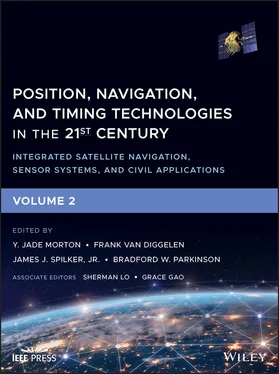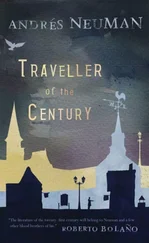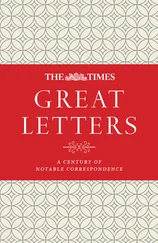When GNSS is not available due to blockage or jamming, mixed SOOP can augment GNSS for indoor positioning [18, 19] and complement GNSS to maintain aiding to an integrated inertial solution [27, 28]. When GNSS is challenged, the internal clock starts to drift even under aiding from other non‐GNSS sensors. To maintain a stable timing source and enable fast reacquisition, it is possible to perform time – and in particular frequency – transfer with SOOP [8, 99]. Early studies showed such a possibility with DTV and CDMA signals to enable fast reacquisition when GNSS becomes available again.
SOOP can also be used for information assurance against spoofing. Cellular networks are synchronized to GPS, and new ATSC standards recommend the same for DTV transmitters. Because spoofing has only a local effect, widely distributed cell towers and DTV transmitters and their GPS timing sources are unlikely to be affected simultaneously by a spoofing attack. As a result, the time and frequency information derived from SOOP can be used as an independent source to mount countermeasures against spoofing.
For public broadcasting stations, information about the transmission characteristics and transmitter location can be found from the regulatory agency’s database. However, there is a need to determine the locations of private and commercial radio and TV broadcasting transmitters, which may not be known to the public, for opportunistic use as a reference for PNT. Such approaches as simultaneous localization and mapping of emitting radio sources (SLAMERS) [16] are valuable for solving the problem. However, from the PNT perspective, the most desirable approach is for broadcasting sources to encode their transmitter location and in particular clock error parameters onto their data stream in a way similar to radio beacons [100]. Transmission of the transmitter’s location and clock data offers an add‐on PNT service to the main business of broadcasting at the expense of intermittent overhead. As part of the accelerated convergence of broadcasting, communications, and Internet, it serves as an enabler of ubiquitous positioning and seamless transition of outdoor and indoor positioning for the burgeoning LBS market.
1 1 Federal Communications Commission (FCC), Guidelines for Testing and Verifying the Accuracy of Wireless E911 Location System, OET Bulletin No. 71, 2000.
2 2 K.W. Kolodziej and J. Hjelm, Local Positioning Systems – LBS Applications and Services, CRC Press, Boca Raton, FL, 2006.
3 3 M.A. Lombardt, NIST Time and Frequency Services, NIST Special Pub. No. 432, January 2002.
4 4 W. Connelly, “TELENAV: A precision navigation system based upon television signal reception,” Navigation: The Journal of the Institute of Navigation, Vol. 33, No. 2, 109–122, Summer 1986.
5 5 J.W. Betz, “Chapter 2: Fundamentals of Satellite‐Based Navigation and Timing,” in Position, Navigation, and Timing Technologies in the 21st Century: Integrated Satellite Navigation, Sensor Systems, and Civil Applications, Y.T.J. Morton, F. van Diggelen, J.J. Spilker, Jr., and B.W. Parkinson (Eds.), Wiley, 2020.
6 6 Y. Wu, S. Hirakawa, U.H. Reimers, and J. Whitaker, “Overview of digital television development worldwide,” Proceedings of the IEEE, Vol. 94, No. 1, 8–21, January 2006.
7 7 M. Rabinowitz and J.J. Spilker, Jr., “A new positioning system using television synchronization signals,” IEEE Transactions on Broadcasting, 51(1), 51–61, March 2005.
8 8 D. Boehm, J. White, S. Mitchell, and E. Powers, “Clock comparison using digital television signals,” 41st Annual Precise Time and Time Interval (PTTI) Meeting, 319–326.
9 9 D. Serant, O. Julien, L. Ries, P. Thevenon, and M. Dervin, “The digital TV case – positioning with signals of opportunity based on OFDM modulation,” Inside GNSS, November/December 2011, 54–62.
10 10 P. Thevenon, S. Damien, O. Julien, C. Macabiau, M. Bousquet, L. Ries, Lionel, and S. Corazza, “Positioning using mobile TV based on the DVB‐SH standard,” ION Journal: Navigation, Vol. 58, No. 2, 71–90, Summer 2011.
11 11 C. Yang, T. Nguyen, D. Qiu, M. Quigley, J. Casper, and B. Wilson, “Mobile positioning with DTV signals (ATSC 8VSB and M/H Standards),” ION GNSS, Nashville, Tennessee, September 2012.
12 12 T. Young, “TVGPS, A hybrid location and timing solution for GPS‐challenged and GPS‐denied environments,” Proceedings of the ION–JSFE JNC, June 2009, Orlando, FL.
13 13 C. Yang and A. Soloviev, “Covariance analysis of spatial and temporal effects of collaborative navigation,” Navigation: Journal of the Institute of Navigation, Vol. 61, No. 3, 213–225, Fall 2014.
14 14 C. Yang and A. Soloviev, “Distributed estimation schemes for vehicular collaborative navigation,” ION GNSS+2014, September 2014.
15 15 P. Mirowski, T.K. Ho, S. Yi, and M. MacDonald, “SignalSLAM: Simultaneous localization and mapping with mixed WiFi, Bluetooth, LTE and magnetic signals,” International Conference on Indoor Positioning and Indoor Navigation (IPIN), 2013.
16 16 C. Yang and A. Soloviev, “Simultaneous localization and mapping of emitting radio sources – SLAMERS,” ION GNSS+2015, September 2015.
17 17 C. Yang and T. Nguyen, “Self‐calibrating position location using signals of opportunities,” ION GNSS’2009, Savannah, Georgia, September 2009.
18 18 M. Rabinowitz and J.J. Spilker, Jr., “Augmenting GPS with television signals for reliable indoor positioning,” ION Journal: Navigation, Vol. 51, No. 4, 269–282, Winter 2004.
19 19 M. Martone and J. Matzler, “Prime time positioning using broadcast TV signals to fill in GPS acquisition gap,” GPS World, 52–60, September 2005.
20 20 K. Carter, R. Ramlall, M. Tummala, and J. McEachen, “Bandwidth efficient ATSC TDOA positioning in GPS‐denied environments,” Proceedings of ION‐ITM, January 2012.
21 21 C. Yang, T. Nguyen, D. Venable, M. White, and R. Siegel, “Cooperative position location with signals of opportunity,” Proceedings of IEEE NAECON, July 2009.
22 22 A. Soloviev and C. Yang, “Cooperative exploitation for indoor geolocation,” ION GNSS+ 2013, 16–20 September 2013, Nashville, TN.
23 23 C. Yang and T. Nguyen, “Tracking and relative positioning with mixed signals of opportunity,” Navigation: Journal of the Institute of Navigation, Vol. 62, No. 4, 291–311, Winter 2015.
24 24 C. Yang and A. Soloviev, Method and apparatus for fusing referenced and self‐contained displacement measurements for positioning and navigation, Patent No. US 8,164,514, 24 April 2012.
25 25 F. van Graas and A. Soloviev, “Precise velocity estimation using a stand‐alone GPS receiver,” ION Journal: Navigation, Vol. 51, No. 4, 283–292, Winter 2004.
26 26 A. Soloviev and C. Yang, “Reconfigurable integration filter engine for plug‐and‐play navigation,” ION GNSS+ 2013, 16–20 September 2013, Nashville, TN.
27 27 C. Yang and A. Soloviev, “Positioning with mixed signals of opportunity subject to multipath and clock errors in urban mobile fading environments,” ION GNSS+, September 2018.
28 28 C. Yang and A. Soloviev, “Mobile Positioning with Signals of Opportunity in Urban and Urban Canyon Environments,” IEEE/ION PLANSx, St. Louis, Missouri, September 2020.
29 29 C. Yang, T Nguyen, and E. Blasch, “Mobile positioning via fusion of mixed signals of opportunity,” IEEE AES Magazine, 2014.
30 30 C. Yang, T. Nguyen, D. Qiu, J. Casper, and M. Quigley, “Positioning with mixed signals of opportunity,” ION GNSS’2011, Portland, Oregon, September 2011.
31 31 R.M. Faragher, Effects of multipath interference on radio positioning systems, PhD dissertation, University of Cambridge, 2007.
32 32 C. Gentner, T. Jost, and A. Dammann, Accurate indoor positioning using multipath components, Proceedings of ION GNSS+2013, Nashville, Tennessee, September 2013.
Читать дальше











